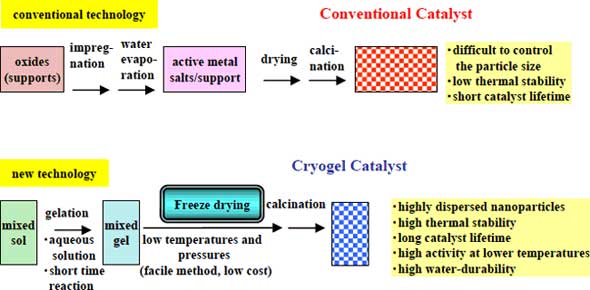| Posted: August 14, 2006 |
Development of a highly functional catalyst for purification of industrial exhaust gases |
|
(Nanowerk News) Researchers of the Meso-Porous Ceramics Group of the Materials Research Institute for Sustainable Development and the Advanced Sintering Technologies Group of the Advanced Manufacturing Research Institute, both from the National Institute of Advanced Industrial Science and Technology (AIST) in Japan, together with NGK Insulators Ltd., have succeeded in developing a highly porous platinum-alumina catalyst for use in industrial exhaust gas purificators with the characteristic of high temperature resistance coupled with a high efficiency.
|
|
The reaction temperature of this catalyst is 100°C lower than the reaction temperatures of the catalysts currently in use, and the thermal resistance has been improved to approximately 200°C. The characteristics of this catalyst, together with the use of low cost aluminum hydroxide as the starting material, and the implementation of a low cost and simple process such as freeze-drying, will lead to the spread of its applications.
|
|
Catalysts containing platinum or other precious metal particles supported on alumina are used for removal by oxidation of the VOC (volatile organic compounds) that are included in the waste gases of factories. Traditionally, these catalysts have been prepared by the impregnation method to easily support the precious metal particles. However, this method has as drawbacks the low dispersibility of the precious metal and the non-homogeneity of the particle diameter. Moreover, as the temperature reaches several hundred degrees during the catalytic reaction, the surface area is reduced by sintering of the particles. In consequence, the catalytic activity is decreased and the lifetime is shortened.
|
|
Based on the technology for the manufacture of highly porous materials developed at AIST, a new processing method for a homogeneous platinum-alumina gel was focused on, with freeze-drying chosen as a low cost and simple process to dry this gel.
|
 |
| Comparison of current and new technologies (Source: AIST)
|
|
As a result, not only was improvement of catalytic activity and durability at high temperature achieved, but it was also possible to manufacture a new highly porous platinum-alumina ceramic body with high durability characteristics. As the material is manufactured through low temperature freeze-drying, it has been named "platinum-alumina cryogel."
|
|
Boehmite sol, low cost aluminum hydroxide, is the starting material for this cryogel catalyst. Use of chelating agents such as oxalic acid and malonic acid when adding the platinum source to the sol, protects the platinum ion, contributing to suppression of precipitation of platinum black, and producing a homogeneous dispersion of ultra fine platinum particles. As the freeze-drying process is carried out without using solvent for substitution of the damp gel, there is not overflow of precious metal ions.
|
|
Removal of methane in air by oxidation was carried out to assess the efficiency of the cryogel catalyst manufactured. It is possible to achieve sufficient removal at a reaction temperature approximately 100°C lower than that of current catalysts.
|
|
Until recently, it was not possible to obtain heat resistance catalysts using traditional manufacturing methods, and sintering of ultra fine particles of platinum occurred. In the case of a cryogel catalyst there is homogeneous distribution of platinum particles of approximately 1 nm in size. It is thought that a strong interaction between the cryogel carrier and the ultra fine platinum particles hinders the sintering of the fine particles, imparting a thermal resistance characteristic to the catalyst. This ultra fine structure may also determine that the catalytic reaction advances effectively even at low temperatures.
|

